Pneumococcal polysaccharide vaccine (PPV): coverage report, England, April 2024 to March 2025
Updated 28 August 2025
Applies to England
Main points
This annual report presents Pneumococcal Polysaccharide Vaccine (PPV) coverage and uptake data by age group and clinical risk group from April 2024 to March 2025.
The main findings were that:
-
coverage in those aged 65 and over was 73.6%, an increase of 0.5 percentage points compared with the 2023 to 2024 financial year [note 1]
-
uptake was 15.4% in those aged 65, a decrease of 0.3 percentage points compared with the 2023 to 2024 financial year [note 1]
-
coverage increased with age from 35.8%, in those aged 65, to 85.6% in those aged 75 and over
-
coverage in those aged 2 to 64 in one or more clinical risk group was 47.5%
-
coverage in clinical risk groups ranged from 39.0% (chronic liver disease) to 70.0% (cochlear implants)
Note 1: The coverage report for financial year 2023 to 2024 included data from only 1 GP IT supplier, due to data quality issues.
Introduction
Pneumococcal disease can present as non-invasive or invasive infections caused by the bacterium Streptococcus pneumoniae (also called pneumococcus). Non-invasive disease includes middle ear infections (otitis media), sinusitis and bronchitis, whilst invasive pneumococcal disease (IPD) includes septicaemia, pneumonia and meningitis.
IPD is a significant cause of morbidity and mortality globally and in the UK with more than 4,500 confirmed cases reported in 2023 to 2024 in England (1). Pneumococcal immunisation is currently offered to young children, the elderly (people aged 65 years and over) and individuals with certain medical conditions – because these groups are at the highest risk of IPD (2).
Pneumococcal immunisation has been recommended for clinical risk groups since 1992 (2). The pneumococcal immunisation programme was introduced in the UK in August 2003 and offered a single dose of PPV to people aged 80 years and over in addition to those at high risk under 65 years of age (2). In April 2004, the programme was expanded to include all people aged 75 years and over. Since April 2005, all people aged 65 years and over have been eligible for the vaccine.
PPV (also currently known as PPV23) is an inactivated vaccine that contains purified polysaccharide from 23 capsular pneumococcus types, including the 10 most prevalent serotypes: 14, 9V, 1, 8, 23F, 4, 3, 6B, 19F and 7F. Most healthy adults develop a good antibody response to a single dose of PPV (2). Among people aged 65 years and over, PPV offers moderate short-term protection against IPD caused by the 23 serotypes targeted by the vaccine (3). In contrast, children younger than 2 years of age show poor antibody response to vaccination with PPV and there is no evidence to support effectiveness of the vaccine among this population group (2). Children younger than 2 years of age are therefore offered a pneumococcal conjugate vaccine (PCV13) through the childhood immunisation programme. Further information on PPV vaccine eligibility is available in ‘Immunisation against infectious disease’ (the Green Book) (2).
This report describes vaccine coverage and uptake of the pneumococcal polysaccharide vaccine (PPV) programme in England. The report includes data from adults aged 65 years and over and individuals aged 2 to 64 years in 9 clinical risk groups associated with elevated risk of adverse outcomes of pneumococcal disease. The current report presents vaccine coverage and uptake estimates for the period between 1 April 2024 to 31 March 2025 (the financial year, referred to below as “2024/25”).
Methods
Data sources
The current report presents PPV coverage and uptake estimates among GP-registered individuals in England.
GP IT suppliers used a standardized script to automatically extract GP-level data from medical records of individuals who were registered with a GP in England on the last day of the collection period which was 31 March 2025.
This data was automatically uploaded to the ImmForm website [note 2] and was then validated and analysed by the UK Health Security Agency (UKHSA) to check data completeness, identify anomalous data and describe epidemiological trends.
Note 2: ImmForm is the system used by UKHSA to record vaccine coverage data for some Immunisation programmes and to provide vaccine ordering facilities for the National Health Service (NHS).
Data collected
The number of individuals registered with the GP and the number vaccinated with PPV were captured by age group, clinical risk group and gender. Data is presented for those who were eligible for the vaccine which includes those aged 65 and over and those aged 2 to 64 in clinical risk groups, as described below.
The age groups included are:
- 65 years
- 66 years
- 67 years
- 68 years
- 69 years
- 70 years
- 71 years
- 72 years
- 73 years
- 74 years
- 65 years and over
- 75 years and over
Clinical risk groups
The clinical risk groups included are:
- asplenia
- chronic respiratory disease
- chronic heart disease
- chronic kidney disease
- chronic liver disease
- diabetes requiring insulin or oral hypoglycaemic medication
- immunosuppression
- cochlear implants
- cerebrospinal fluid leak
Gender groups
The gender groups included are:
- men
- women
- gender unknown
Gender unknown includes individuals whose gender was coded as ‘Gender – unknown’ or ‘Gender – unspecified’.
Definitions of ‘uptake’ and ‘coverage’
This report includes figures for vaccine uptake and coverage.
Coverage measures the proportion of the eligible population who have received the vaccine at any time. This measure shows the overall level of protection in the group.
Uptake measures the proportion of the eligible population who have received the vaccine in the past year. This measure shows the level of recent vaccination activity and can be used to estimate how soon after becoming eligible individuals receive the vaccine.
For clinical risk groups we report coverage in all patients registered as ‘at risk’ to assess the overall level of protection in those at higher risk of adverse outcomes from IPD. We also report uptake in those who have recently become ‘at risk’ to assess the timeliness of vaccination.
Vaccine coverage among individuals aged 65 years and over
This is the percentage of GP-registered individuals who were 65 years and over on 31 March 2025 and who received PPV any time on or before 31 March 2025.
Vaccine uptake among individuals aged 65 years and over
This is the percentage of GP-registered individuals who were 65 years and over on 31 March 2025 and who received PPV between 1 April 2024 and 31 March 2025.
Vaccine coverage among individuals aged 2 to 64 years in one or more clinical risk groups
This is the percentage of GP-registered individuals, who were 2 to 64 years old on 31 March 2025, who were in one or more clinical risk groups on 31 March 2025 and who received PPV any time on or before 31 March 2025.
Vaccine uptake among individuals aged 2 to 64 years newly in one or more clinical risk groups
This is the percentage of GP-registered individuals, who were 2 to 64 years old on 31 March 2025, who joined one or more clinical risk groups between 1 April 2023 and 31 March 2024 and who receivedÃ˝PPVÃ˝between 1 April 2023 and 31 March 2025.
Vaccine coverage among individuals aged 2 to 64 years in individual clinical risk groups
This is the percentage of GP-registered individuals, who were 2 to 64 years old on 31 March 2025, who were in an individual clinical risk group on 31 March 2025, and who received PPV any time on or before 31 March 2025.
Vaccine uptake among individuals aged 2 to 64 years newly in individual clinical risk groups
This is the percentage of GP-registered individuals, who were 2 to 64 years old on 31 March 2025, who joined an individual risk group between 1 April 2023 and 31 March 2024 and who received PPV between 1 April 2023 and 31 March 2025.
Vaccine coverage and uptake among individuals aged 65 years and over are presented overall and by age group and gender. Vaccination coverage and uptake among individuals aged 2 to 64 years in one or more clinical risk groups are presented overall and by gender. For this measure, individuals in multiple clinical risk groups were only counted once. Vaccination coverage among individuals aged 2 to 64 years is also presented for individual clinical risk groups. For this measure, individuals in multiple clinical risk groups were counted multiple times. This means the total number of ‘at risk’ individuals by individual clinical risk group is not directly comparable to the number of ‘at risk’ individuals overall and by gender.
Results
Response summary
The figures presented in this report for financial year 2024 to 2025 (“2024/25”) include data from 99.1% of GP Practices (6,168 out of 6,225). Figures from the 2023/24 financial year include data from only 40.0% of GPs, due to data quality issues.
Coverage and uptake among individuals aged 65 and over
PPV coverage by age group
Coverage is the proportion of those aged 65 and over who have been vaccinated at any time. This provides an indicator of overall protection in these age groups.
PPV coverage was 73.6% among those aged 65 and over (Table 1).
Coverage gradually increased with age, rising from 35.8% in those aged 65 to 85.6% in those aged 75 and over (Figure 1).
Coverage in those aged 65 and over increased by 0.5 percentage points between financial years 2023/24 and 2024/25 (Figure 2).
Table 1. PPV vaccine coverage and uptake among individuals aged 65 and over on 31 March 2025, by age group, in England
| Age group | Number registered on 31 March 2025 | Number vaccinated between 1 April 2024 and 31 March 2025 | PPV uptake (%) | Number vaccinated on or before 31 March 2025 | PPV coverage (%) |
|---|---|---|---|---|---|
| 65Ã˝ | Ã˝675,190Ã˝ | Ã˝103,830Ã˝ | Ã˝15.4Ã˝ | Ã˝241,758Ã˝ | Ã˝35.8 |
| 66Ã˝ | Ã˝655,876Ã˝ | Ã˝81,165Ã˝ | Ã˝12.4Ã˝ | Ã˝312,237Ã˝ | Ã˝47.6 |
| 67Ã˝ | Ã˝634,305Ã˝ | Ã˝44,074Ã˝ | Ã˝6.9Ã˝ | Ã˝333,481Ã˝ | Ã˝52.6 |
| 68Ã˝ | Ã˝600,751Ã˝ | Ã˝33,272Ã˝ | Ã˝5.5Ã˝ | Ã˝349,810Ã˝ | Ã˝58.2 |
| 69Ã˝ | Ã˝571,176Ã˝ | Ã˝26,013Ã˝ | Ã˝4.6Ã˝ | Ã˝364,230Ã˝ | Ã˝63.8 |
| 70Ã˝ | Ã˝551,759Ã˝ | Ã˝28,717Ã˝ | Ã˝5.2Ã˝ | Ã˝380,189Ã˝ | Ã˝68.9 |
| 71Ã˝ | Ã˝545,883Ã˝ | Ã˝22,796Ã˝ | Ã˝4.2Ã˝ | Ã˝399,102Ã˝ | Ã˝73.1 |
| 72Ã˝ | Ã˝524,655Ã˝ | Ã˝15,800Ã˝ | Ã˝3.0Ã˝ | Ã˝396,719Ã˝ | Ã˝75.6 |
| 73Ã˝ | Ã˝509,420Ã˝ | Ã˝12,970Ã˝ | Ã˝2.5Ã˝ | Ã˝394,078Ã˝ | Ã˝77.4 |
| 74Ã˝ | Ã˝503,668Ã˝ | Ã˝11,858Ã˝ | Ã˝2.4Ã˝ | Ã˝398,148Ã˝ | Ã˝79.0 |
| 75 and overÃ˝ | Ã˝5,630,207Ã˝ | Ã˝101,882Ã˝ | Ã˝1.8Ã˝ | Ã˝4,819,564Ã˝ | Ã˝85.6 |
| Total | 11,402,890Ã˝ | Ã˝482,377Ã˝ | Ã˝4.2Ã˝ | Ã˝8,389,316Ã˝ | Ã˝73.6 |
Figure 1. PPV vaccine uptake and coverage among individuals aged 65 and over on 31 March 2025, by age group in England
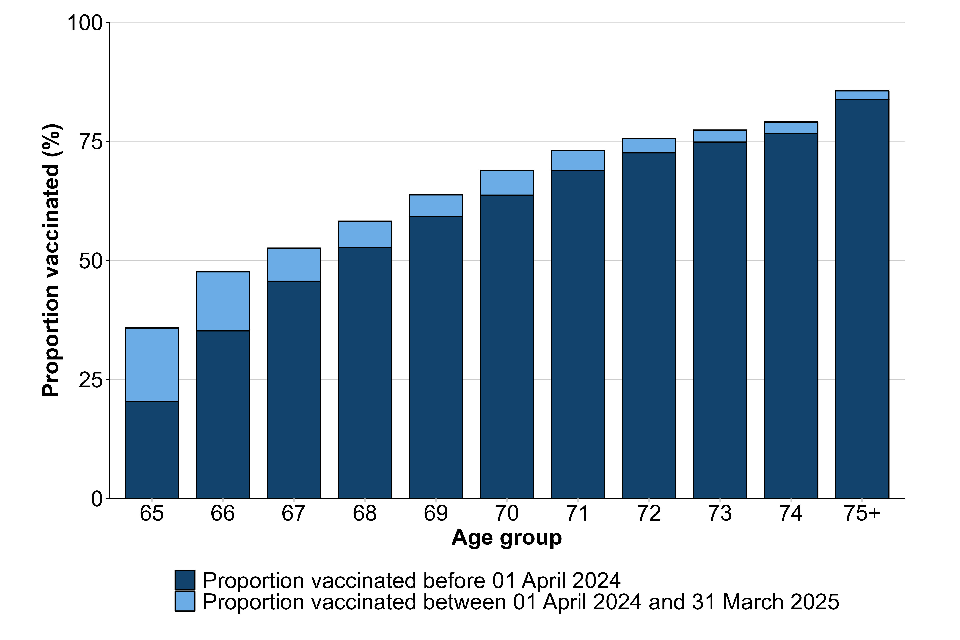
Figure 2. Trends in PPV vaccine coverage among individuals aged 65 and over from the 2016 to 2017 financial year to the 2024 to 2025 financial year, by age group, in England
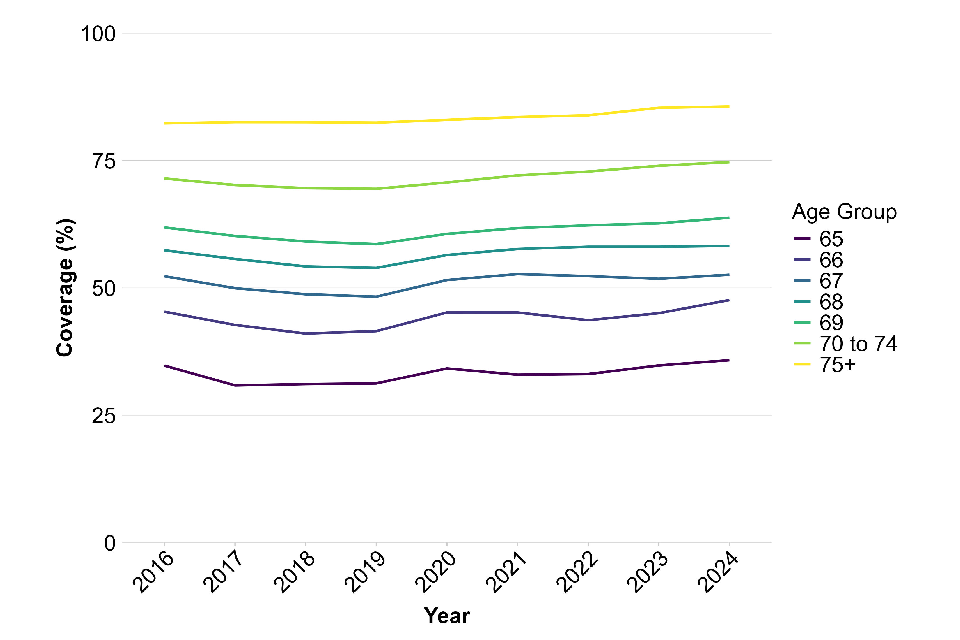
PPV uptake by age group
Uptake is the proportion of those eligible who have been vaccinated in the last year. This provides an indicator of vaccination activity in 2024/25 and shows how long after becoming eligible individuals are receiving the vaccine.
Uptake was 15.4% in those aged 65 who had recently become eligible for the vaccine (Table 1). Uptake in those aged 65 decreased by 0.3 percentage points between financial years 2023/24 and 2024/25 (Figure 3).
Uptake decreased with age (as a larger proportion of the population had already been vaccinated) falling to 1.8% in those aged 75 and over (Figure 1). The only exception to this trend was in 70 year olds whose uptake was 5.2%, which was higher than the uptake in those aged 69 (4.6%). Overall, uptake was 4.2% among those aged 65 and over (Table 1).
Figure 3. Trends in PPV vaccine uptake among individuals aged 65 and over from the 2016 to 2017 financial year to the 2024 to 2025 financial year, by age group, in England
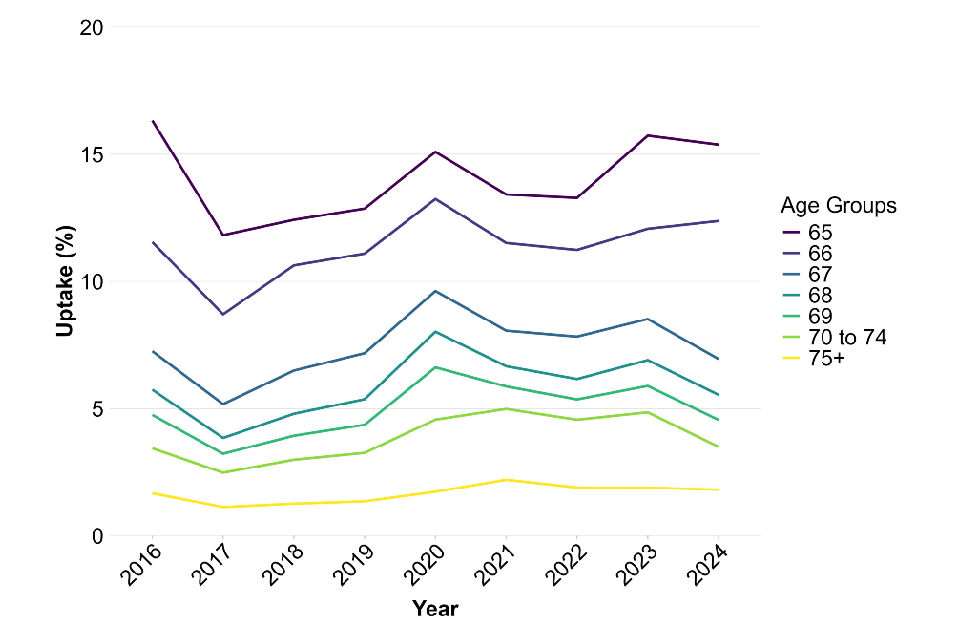
PPV coverage and uptake by gender
Among individuals aged 65 years and over, coverage was 73.8% for women and 73.3% for men. Since April 2024, the uptake in this age group was 4.1% for women and 4.4% for men (Table 2).
Table 2. PPV vaccine coverage and uptake among individuals aged 65 and over on 31 March 2025, by gender, in England
| Gender | Number registered on 31 March 2025 | Number vaccinated between 1 April 2024 and 31 March 2025 | PPV uptake (%) | Number vaccinated on or before 31 March 2025 | PPV coverage (%) |
|---|---|---|---|---|---|
| Male | 5,275,467 | 230,752 | 4.4 | 3,865,404 | 73.3 |
| Female | 6,127,330 | 251,619 | 4.1 | 4,523,865 | 73.8 |
| Gender unknown [note 3] | 93 | 6 | 6.5 | 47 | 50.5 |
| Total | 11,402,890 | 482,377 | 4.2 | 8,389,316 | 73.6 |
Note 3: Gender unknown includes individuals whose gender is coded as ‘Gender – unknown’ or ‘Gender – unspecified’
PPV coverage and uptake by commissioning region
Among individuals aged 65 years and over, coverage varied by 7.3 percentage points between commissioning regions. Coverage was lowest in London (67.7%) and highest in the North East and Yorkshire (75.0%). Uptake also varied by 1.3 percentage points between commissioning regions and was lowest in the North West (3.7%) and highest in the East of England (5.0%).
Table 3. PPV vaccine coverage and uptake among individuals aged 65 and over on 31 March 2025, by commissioning region, in England
| Commissioning region | Number registered on 31 March 2025 | Number vaccinated between 1 April 2024 and 31 March 2025 | PPV uptake (%) | Number vaccinated on or before 31 March 2025 | PPV coverage (%) |
|---|---|---|---|---|---|
| LondonÃ˝ | Ã˝1,236,693Ã˝ | Ã˝48,501Ã˝ | Ã˝3.9Ã˝ | Ã˝836,710Ã˝ | Ã˝67.7 |
| South WestÃ˝ | Ã˝1,375,884Ã˝ | Ã˝60,853Ã˝ | Ã˝4.4Ã˝ | Ã˝1,021,101Ã˝ | Ã˝74.2 |
| South EastÃ˝ | Ã˝1,930,890Ã˝ | Ã˝83,751Ã˝ | Ã˝4.3Ã˝ | Ã˝1,442,253Ã˝ | Ã˝74.7 |
| MidlandsÃ˝ | Ã˝2,233,180Ã˝ | Ã˝94,030Ã˝ | Ã˝4.2Ã˝ | Ã˝1,643,402 | Ã˝73.6 |
| East of EnglandÃ˝ | Ã˝1,397,462Ã˝ | Ã˝69,889Ã˝ | Ã˝5.0Ã˝ | Ã˝1,035,726 | Ã˝74.1 |
| North WestÃ˝ | Ã˝1,431,387Ã˝ | Ã˝52,583Ã˝ | Ã˝3.7Ã˝ | Ã˝1,061,404 | Ã˝74.2 |
| North East and YorkshireÃ˝ | Ã˝1,797,394Ã˝ | Ã˝72,770Ã˝ | Ã˝4.0Ã˝ | Ã˝1,348,720 | Ã˝75.0 |
| Total | 11,402,890Ã˝ | Ã˝482,377Ã˝ | Ã˝4.2Ã˝ | Ã˝8,389,316Ã˝ | Ã˝73.6 |
Figure 4. Trends in PPV vaccine uptake among individuals aged 65 from the 2016 to 2017 financial year to the 2024 to 2025 financial year, by Commissioning Region, in England
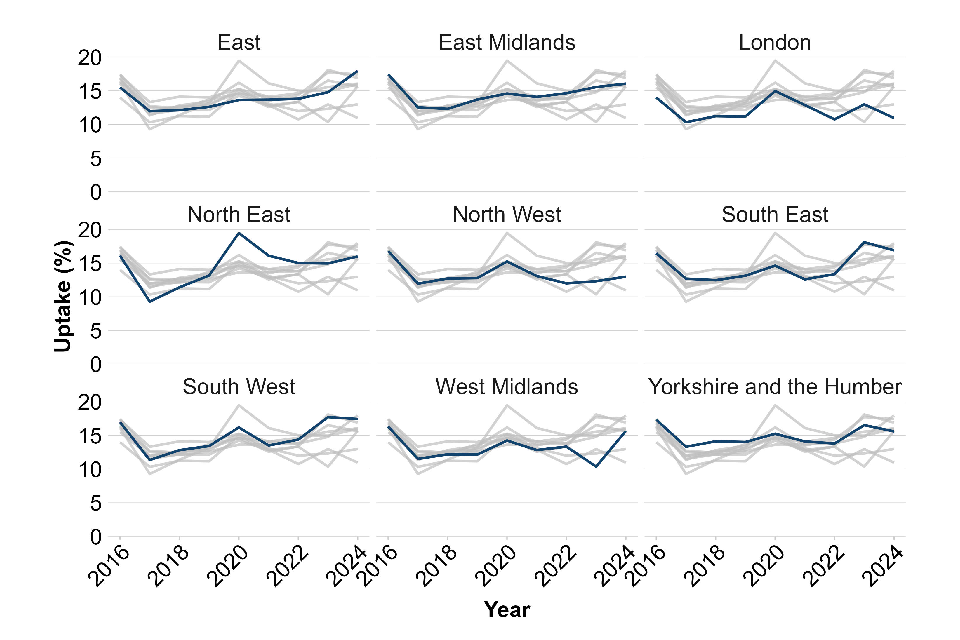
Figure 5. Trends in PPV vaccine coverage among individuals aged 65 and over from the 2016 to 2017 financial year to the 2024 to 2025 financial year, by Commissioning Region, in England
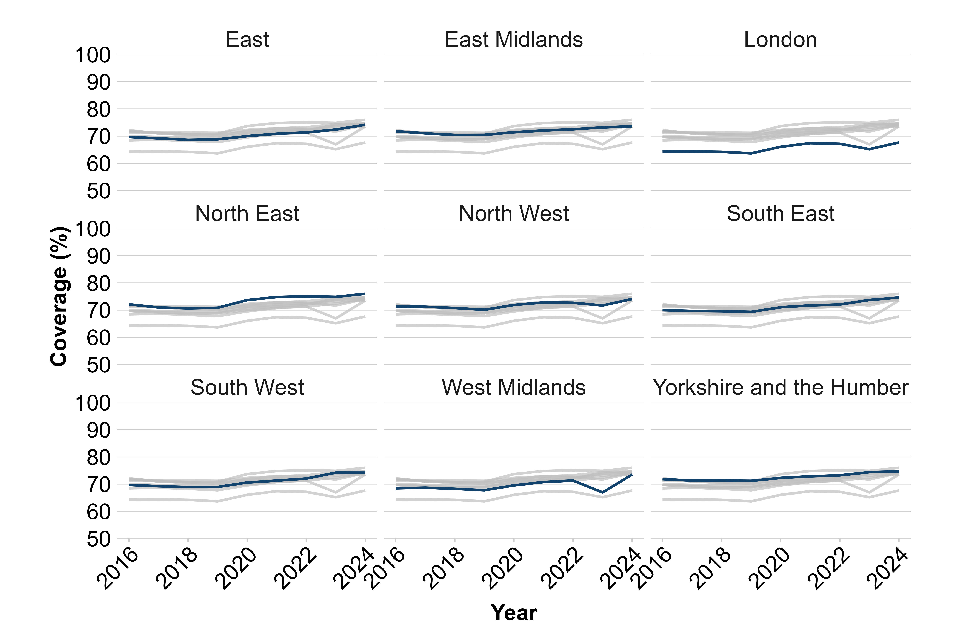
Coverage and uptake among individuals aged 2 to 64 in clinical risk groups
Coverage among individuals aged 2 to 64 in clinical risk groups
Coverage for those in a clinical risk group is the proportion of those aged 2 to 64 registered as at risk who have been vaccinated at any time. This provides an indicator of overall protection in all at risk patients.
Overall coverage among individuals aged 2 to 64 years in one or more clinical risk groups was 47.5%. Coverage in individual risk groups ranged from 39.0% in those with Chronic Liver Disease to 70.0% in those with Cochlear Implants (Table 3).
Table 4. PPV vaccine coverage and uptake among individuals aged 2 to 64 on 31 March 2025, by individual risk group, in England
| Clinical risk group | Number newly-registered as ‘at risk’ between 1 April 2023 and 31 March 2024 | Number vaccinated between 1 April 2023 and 31 March 2025 | PPV uptake (%) | Number registered as ‘at risk’ on 31 March 2025 | Number vaccinated on or before 31 March 2025 | PPV coverage (%) |
|---|---|---|---|---|---|---|
| Asplenia / dysfunction of the spleen | 13,134Ã˝ | Ã˝3,521Ã˝ | Ã˝26.8Ã˝ | Ã˝261,234Ã˝ | Ã˝144,717Ã˝ | Ã˝55.4 |
| Chronic respiratory disease | Ã˝46,650Ã˝ | Ã˝13,887Ã˝ | Ã˝29.8Ã˝ | Ã˝613,437Ã˝ | Ã˝319,214Ã˝ | Ã˝52.0 |
| Chronic heart disease | 55,745Ã˝ | Ã˝10,162Ã˝ | Ã˝18.2Ã˝ | Ã˝725,884Ã˝ | Ã˝347,740Ã˝ | Ã˝47.9 |
| Chronic kidney disease | 3,879Ã˝ | Ã˝677Ã˝ | Ã˝17.5Ã˝ | Ã˝95,873Ã˝ | Ã˝52,944Ã˝ | Ã˝55.2 |
| Chronic liver disease | 17,093Ã˝ | Ã˝2,369Ã˝ | Ã˝13.9Ã˝ | Ã˝221,355Ã˝ | Ã˝86,340Ã˝ | Ã˝39.0 |
| Diabetes requiring insulin or oral hypoglycaemic medication | 136,863Ã˝ | Ã˝34,850Ã˝ | Ã˝25.5Ã˝ | Ã˝1,766,938Ã˝ | Ã˝982,665Ã˝ | Ã˝55.6 |
| Immuno-suppression | Ã˝67,246Ã˝ | Ã˝13,242Ã˝ | Ã˝19.7Ã˝ | Ã˝1,140,435Ã˝ | Ã˝493,707Ã˝ | Ã˝43.3 |
| Cochlear implants | Ã˝453Ã˝ | Ã˝169Ã˝ | Ã˝37.3Ã˝ | Ã˝11,754Ã˝ | Ã˝8,231Ã˝ | Ã˝70.0 |
| Cerebrospinal fluid leaks | 309Ã˝ | Ã˝52Ã˝ | Ã˝16.8Ã˝ | Ã˝6,412Ã˝ | Ã˝2,688Ã˝ | Ã˝41.9 |
Uptake among individuals aged 2 to 64 newly in clinical risk groups
Uptake for those newly in a clinical risk group is the proportion of those aged 2 to 64 who have newly become at risk who have been vaccinated recently. This provides an indicator of the timeliness of vaccination as it shows whether individuals are receiving their vaccination soon after becoming at risk.
Overall uptake among individuals aged 2 to 64 years newly entering one or more clinical risk groups was 22.9%. Uptake in individual risk groups ranged from 13.9% in those with Chronic Liver Disease to 37.3% in those with Cochlear Implants (Table 3).
PPV coverage and uptake in those aged 2 to 64 in clinical risk groups by gender
Among individuals in one or more at risk groups, coverage was 46.8% for men and 48.3% for women. Uptake since April 2024 was 22.1% for men and 23.9% for women (Table 5).
Table 5. PPV vaccine coverage and uptake among individuals aged 2 to 64 on 31 March 2025, by individual risk group and gender, in England
| Gender | Number newly-registered as ‘at risk’ between 1 April 2023 and 31 March 2024 | Number vaccinated between 1 April 2023 and 31 March 2025 | PPV uptake (%) | Number registered as ‘at risk’ on 31 March 2025 | Number vaccinated on or before 31 March 2025 | PPV coverage (%) |
|---|---|---|---|---|---|---|
| Male | 181,693Ã˝ | Ã˝40,174Ã˝ | Ã˝22.1Ã˝ | Ã˝2,207,243Ã˝ | Ã˝1,032,441Ã˝ | Ã˝46.8 |
| Female | Ã˝150,201Ã˝ | Ã˝35,913Ã˝ | Ã˝23.9Ã˝ | Ã˝1,945,981Ã˝ | Ã˝940,753Ã˝ | Ã˝48.3 |
| Gender unknown [note 3] | 19Ã˝ | Ã˝7Ã˝ | Ã˝38.9Ã˝ | Ã˝200Ã˝ | Ã˝89Ã˝ | Ã˝44.5 |
| Total | 331,913Ã˝ | Ã˝76,094 | Ã˝22.9 | Ã˝4,153,424 | Ã˝1,973,283 | Ã˝47.5 |
Note 3: Gender unknown includes individuals whose gender is coded as ‘Gender – unknown’ or ‘Gender – unspecified’
PPV coverage and uptake measured by IMD 2019 deprivation quintiles
Among individuals aged 65 and over, PPV coverage measured by IMD quintile shows there is 4.5 percentage points between the most (71.0%) and least deprived deciles (75.5%) (Table 6).
Table 6. PPV vaccine coverage among individuals aged 65 and over on 31 March 2025, measured by IMD 2019 deprivation quintiles, in England [note 2]
| Deprivation Decile | PPV Coverage (%) |
|---|---|
| 1 (Most Deprived) | 71.0 |
| 2 | 72.5 |
| 3 | 74.5 |
| 4 | 74.9 |
| 5 (Least Deprived) | 75.5 |
Note 2: IMD 2019 deprivation quintile uptake and coverage figures are based on GP postcode not residential postcode.
Among individuals aged 65, PPV uptake measured by IMD quintile shows there is 6.7 percentage points between the most (12.0%) and least deprived (18.7%) deciles (Table 7)
Table 7. PPV vaccine uptake among individuals aged 65, measured by IMD 2019 deprivation quintiles, in England [note 3]
| Deprivation Decile | PPV Uptake (%) |
|---|---|
| 1 (Most Deprived) | 12.0 |
| 2 | 14.0 |
| 3 | 16.8 |
| 4 | 17.0 |
| 5 (Least Deprived) | 18.7 |
Note 3: IMD 2019 deprivation quintile uptake and coverage figures are based on GP postcode not residential postcode.
Discussion
Coverage in those aged 65 and over was 73.6%, an increase of 0.5 percentage points compared with 2023/24. Coverage increased with age, as individuals had more time to be vaccinated. This trend demonstrates that PPV continues to be offered opportunistically in primary care to individuals aged 65 years and over who remain eligible as they age.
Uptake in those aged 65 was 15.4%, a decrease of 0.3 percentage points compared with 2023/24. Uptake is expected to decrease with age as older individuals have been eligible for longer so are more likely to have had the vaccine prior to the most recent 12 months. However, in 2024/25, uptake in those aged 70 (5.2%) was higher than those aged 69 (4.6%). This trend may be because those aged 70 would have also recently become eligible for the new Shingrix vaccine and may have been offered the PPV vaccine opportunistically alongside Shingrix.
Coverage by gender was marginally higher in females (73.8%) than in males (73.3%). This was also the case for individuals aged 2 to 64 years in one or more clinical risk groups where vaccine coverage was 48.3% in females and 46.8% in males.
For those in clinical risk groups aged 2 to 64, coverage was 47.5% and coverage varied substantially by individual clinical risk group. Due to the ambiguity of certain clinical codes, there will be individuals eligible for vaccination in clinical risk groups who are not included in these estimates. The differences in coverage among individuals in clinical risk groups may suggest that awareness of eligibility and importance of PPV among individuals and clinicians varies substantially according to clinical risk.
References
1. Bertran M, D’Aeth JC, Abdullahi F, Eletu S, Andrews NJ, Ramsay ME, and others (2024). . The Lancet Infectious Diseases: volume 24, issue 5, pages 546 to 556
2. UKHSA and DHSC. ‘Immunisation against infectious disease, chapter 25: Pneumococcal’ (the Green Book)
3. Djennad A, Ramsay ME, Pebody R and others (2018). ‘’. EClinicalMedicine: volume 6, pages 42 to 50
